With more than half of the year behind us, it has been another busy period for U.S. Public Health Service (USPHS) officers. These officers conduct unannounced sanitation inspections on cruise ships to ensure adherence to the hygiene standards outlined in the Vessel Sanitation Program (VSP) Operations Manual. For those unfamiliar with the program, our previous article, “A Review of VSP Cruise Ship Inspections (2022-2024),” provides a detailed overview of the background and scope of these inspections. At the time of writing, the results from 96 inspections have been published on the VSP website.
From January to the end of July, VSP inspectors visited 92 different cruise ships. The Disney Magic, Margaritaville at Sea Paradise, Radiance of the Seas, and Valiant Lady each underwent two inspections. Sixteen ships were awarded the highest possible score of 100. The Margaritaville at Sea Paradise has been the only vessel to fail its inspection so far this year, receiving a score of 83 on May 1, 2024. However, three vessels—Caribbean Princess, Carnival Breeze, and MSC Magnifica—came close, each scoring 86, which is the threshold for passing an inspection, during their respective VSP visits in May.
In total, 2,879 violations were identified across all inspections. While the most common deficiencies remained consistent with previous years, including pest sightings and out-of-order equipment, there were some intriguing and less frequent findings. In this article, we will explore the top five most interesting ones, discussing both their significance and how cruise lines can ensure compliance in the future.
Table of Contents
1. AGE Case Identification
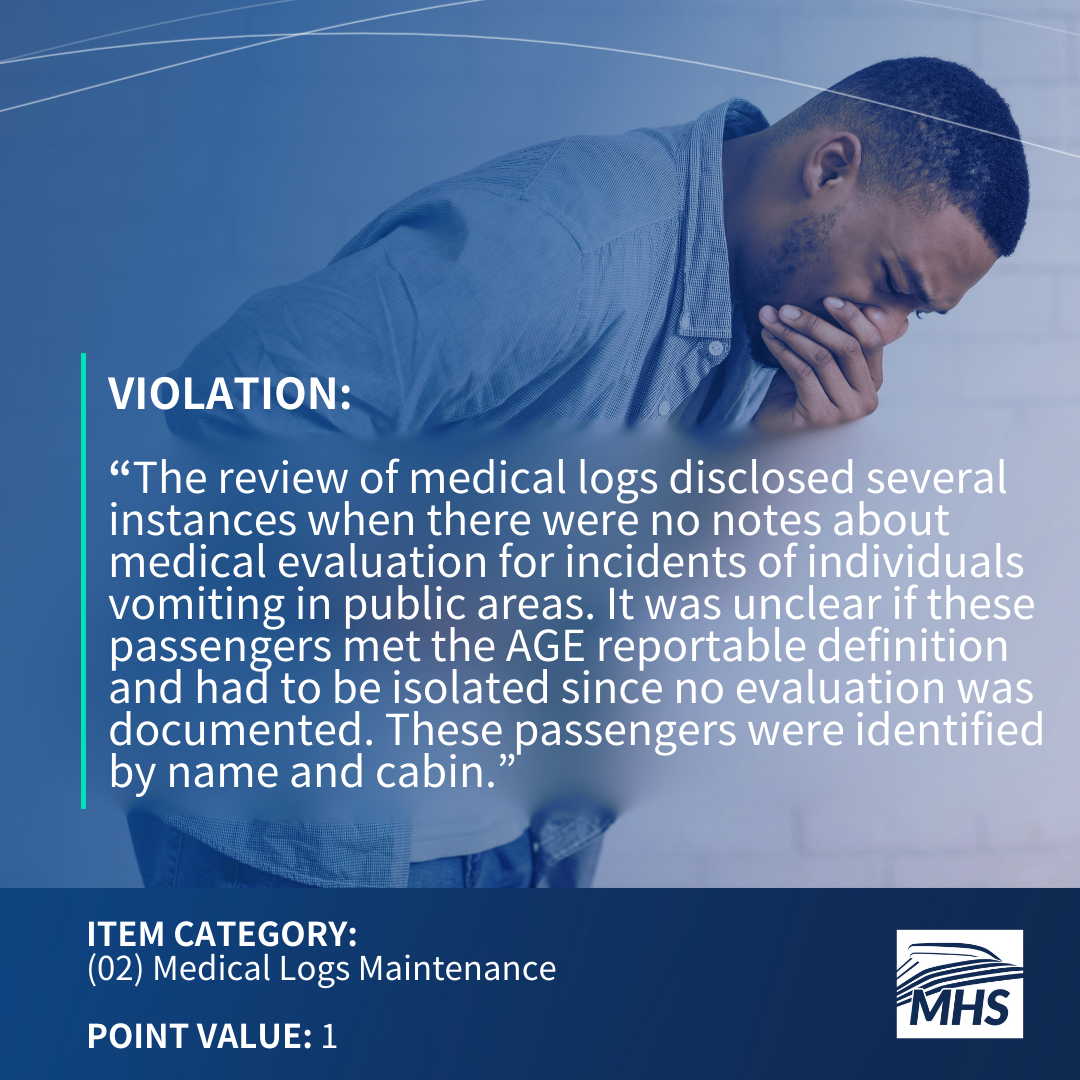
The current VSP Ops Manual does not explicitly require the investigation of public vomiting or diarrhea incidents. Section 13.4.3.5 Useful Information, which addresses acute gastroenteritis (AGE) outbreaks, mentions that the VSP “may request” records from the vessel regarding such incidents during their investigations.
Moreover, Section 9.1.1.1.5 Written OPRP mandates that a vessel’s OPRP (Outbreak Prevention and Response Plan) “must address a graduated approach to outbreak management in response to increasing case counts.” This section also notes that triggers for this approach may be based on events “such as reports of public vomiting/diarrhea, increased room service requests, meal or excursion cancellations, missed events, or others.”
Thus, while there is no explicit standard, it is implied within the manual that these incidents should be investigated. The rationale is to ensure a proper evaluation to determine if individuals who vomit or defecate in public areas meet the criteria for an AGE reportable case. If they do, they should be isolated to prevent further transmission of the disease.
To ensure compliance, vessels should maintain a record of all public vomiting and diarrhea incidents. It is recommended to document the following:
- Incident Details: Date, time, location, and type of incident (vomit or diarrhea).
- Patient Details: If the person responsible for the incident is identified, document their name, cabin number, and whether they are a passenger or crew member. This information should be shared with medical staff for follow-up, and their evaluation should be recorded in the vessel’s medical logs.
- Response Details: Summary of the actions taken.
2. Potentially Hazardous Food Labeling
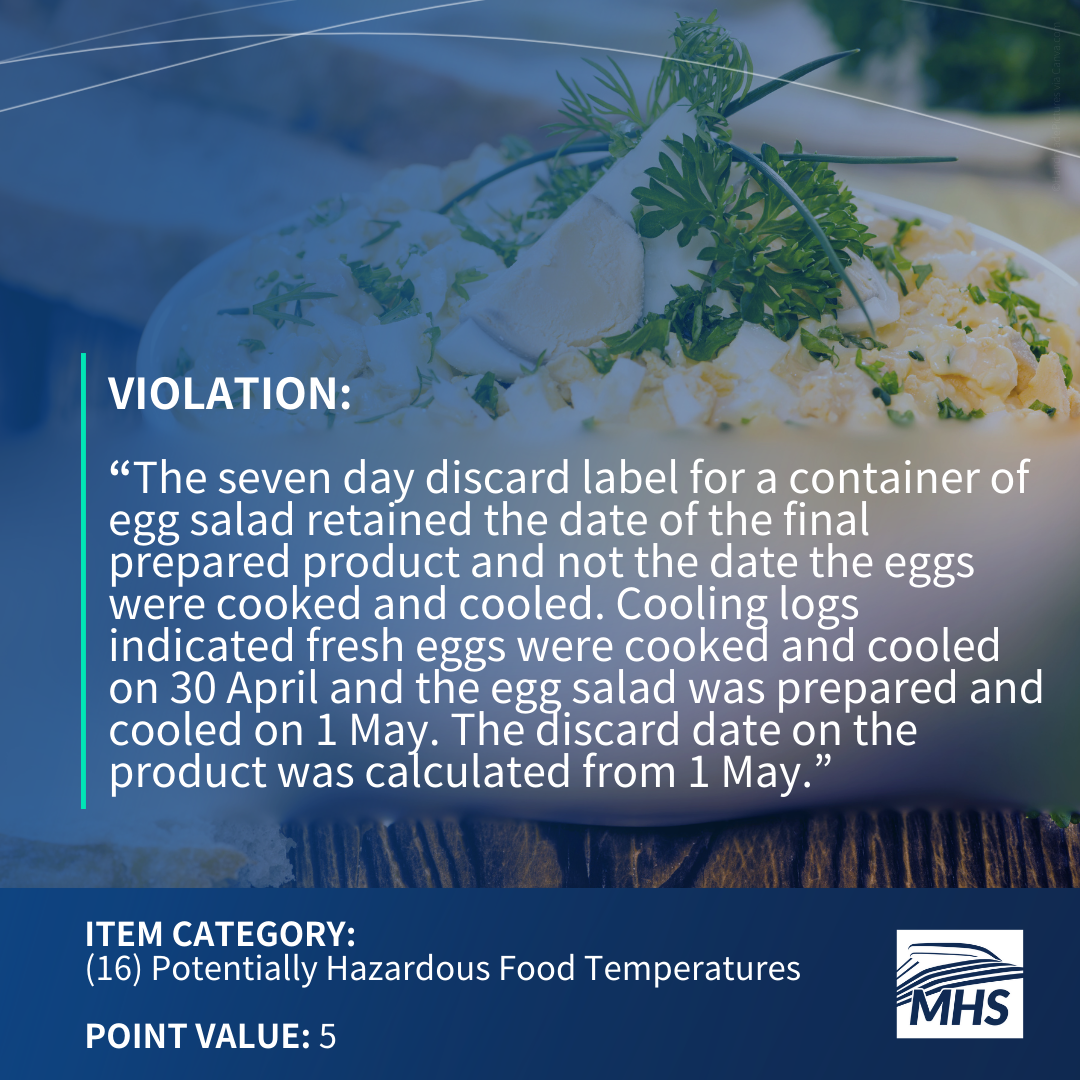
This finding serves as an important reminder: when Potentially Hazardous Food (PHF) ingredients are combined in a Ready-To-Eat (RTE) menu item that is then refrigerated for later consumption, the date marking label must reflect the date of the earliest prepared PHF ingredient.
According to VSP requirements, RTE PHF items prepared on board and stored in a refrigerator for more than 24 hours must be clearly marked to indicate when they must be consumed or discarded. This date must be no later than seven days from the original date of preparation, with the day of preparation counted as Day 1 (Section 7.3.5.3.2 RTE PHF Shelf-Life: Date Marking).
Section 7.3.5.3.4 Retain Date further states:
“A refrigerated, potentially hazardous, READY-TO-EAT FOOD ingredient or a portion of a refrigerated, potentially hazardous, READY-TO-EAT FOOD subsequently combined with additional ingredients or portions of FOOD must retain the date marking of the earliest or first-prepared ingredient.”
VSP 2018 Operations Manual
Therefore, in the above-quoted violation, the date marking label should have indicated that the egg salad was to be served or discarded by no later than 6 May.
3. Cleaning Children’s Books
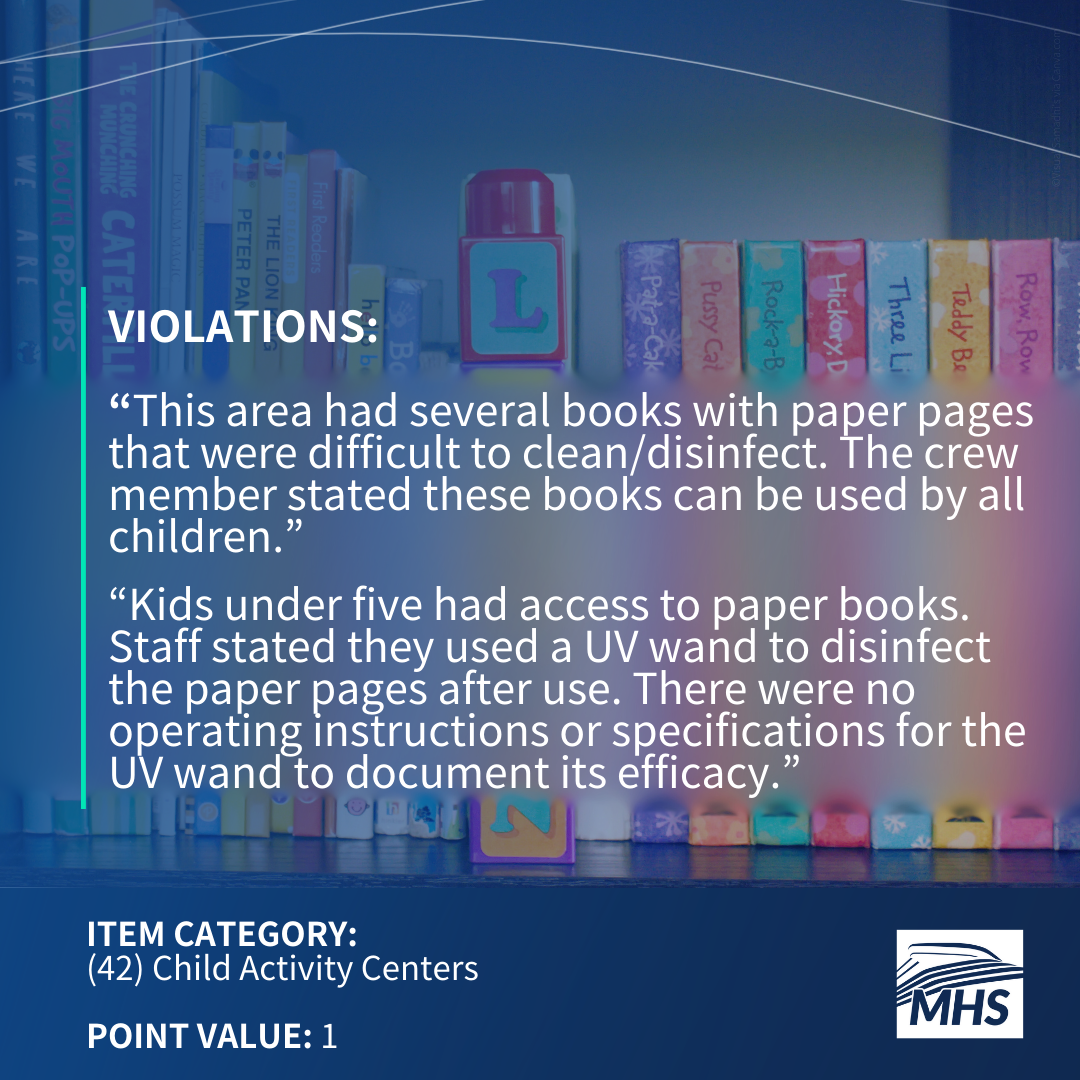
Several violations, similar to those mentioned above, have been reported during VSP inspections this year. These findings have undoubtedly sparked interesting discussions within the cruise lines, both on board and ashore.
First, let’s address the requirements these violations were cited against:
Section 10.3.2.1.1 Cleanable: Surfaces of tables, chairs, and other furnishings that children touch with their hands must be cleanable.
Section 10.3.2.2.1 Hard Surfaces: Surfaces that children touch with their hands must be cleaned and disinfected daily with products labeled by the manufacturer for that purpose.
Section 10.3.2.2.2 Toy Cleaning/Ball Pits: Toys used in the CHILD ACTIVITY CENTER must be cleaned and disinfected daily. Balls used in ball pits/pens must be cleaned when contaminated or at least once per week. If a CHEMICAL DISINFECTANT is used, toys must be air dried before use.
VSP 2018 Operations Manual
The intent of these regulations is clear: to enhance disease prevention efforts on board. Small children are often more susceptible to carrying and spreading certain diseases due to their developing immune systems and frequent close contact with other children, especially in settings like daycare centers, schools, and child activity centers on cruise ships.
However, from a compliance perspective, one could argue that books do not fall under the definitions of furnishings, hard surfaces (at least the paper pages), or toys. If VSP inspections are conducted to ensure adherence to the standards set forth in their manual, one might contend that these findings are not violations—since there is no explicit standard—but rather suggestions for improvement. This could explain why inspectors did not deduct any points for these observations.
While it is theoretically possible to catch viruses and bacteria from paper, the likelihood is generally considered very low. Importantly, no scientific research has documented cases of infection from handling books. Most bacteria and viruses do not survive long on porous surfaces like paper. For instance, studies on SARS-CoV-2, the virus that causes COVID-19, found it was undetectable on book covers after one day and on paper pages after three days. In comparison, the influenza virus can survive for less than 12 hours. Norovirus, rotavirus, and gram-positive bacteria such as strep and staph are likely to persist longer.
The mere presence of germs on surfaces is, however, not enough to cause illness. For surface contamination to lead to infection, a complete transmission chain must occur. An infected person must contaminate a surface, with the pathogen remaining viable and capable of causing infection. A susceptible individual then has to touch the exact spot where viable pathogens are present, and a sufficient amount of viable material must transfer to the person’s hand in a dose large enough to cause infection. Finally, that person has to touch their nose, mouth, or eyes with their contaminated hand, transferring enough of the viable material to their orifices to cause illness. As Albert Einstein once remarked, “In theory, theory and practice are the same. In practice, they are not.”
While cruise lines do have strict child activity center exclusion policies for ill children, it must be recognized that such processes are not foolproof, and small children are undoubtedly more likely to put their hands in their mouths and on their faces. Viewing these violations as opportunities for continuous improvement, replacing paper reading material with glossy hard books that can be wiped with a disinfectant is one possible alternative. Protocols requiring staff to ensure children wash their hands (under supervision) before and after handling books and removing the books during outbreaks could further supplement and enhance disease prevention efforts on board.
4. RWF Bather Loads
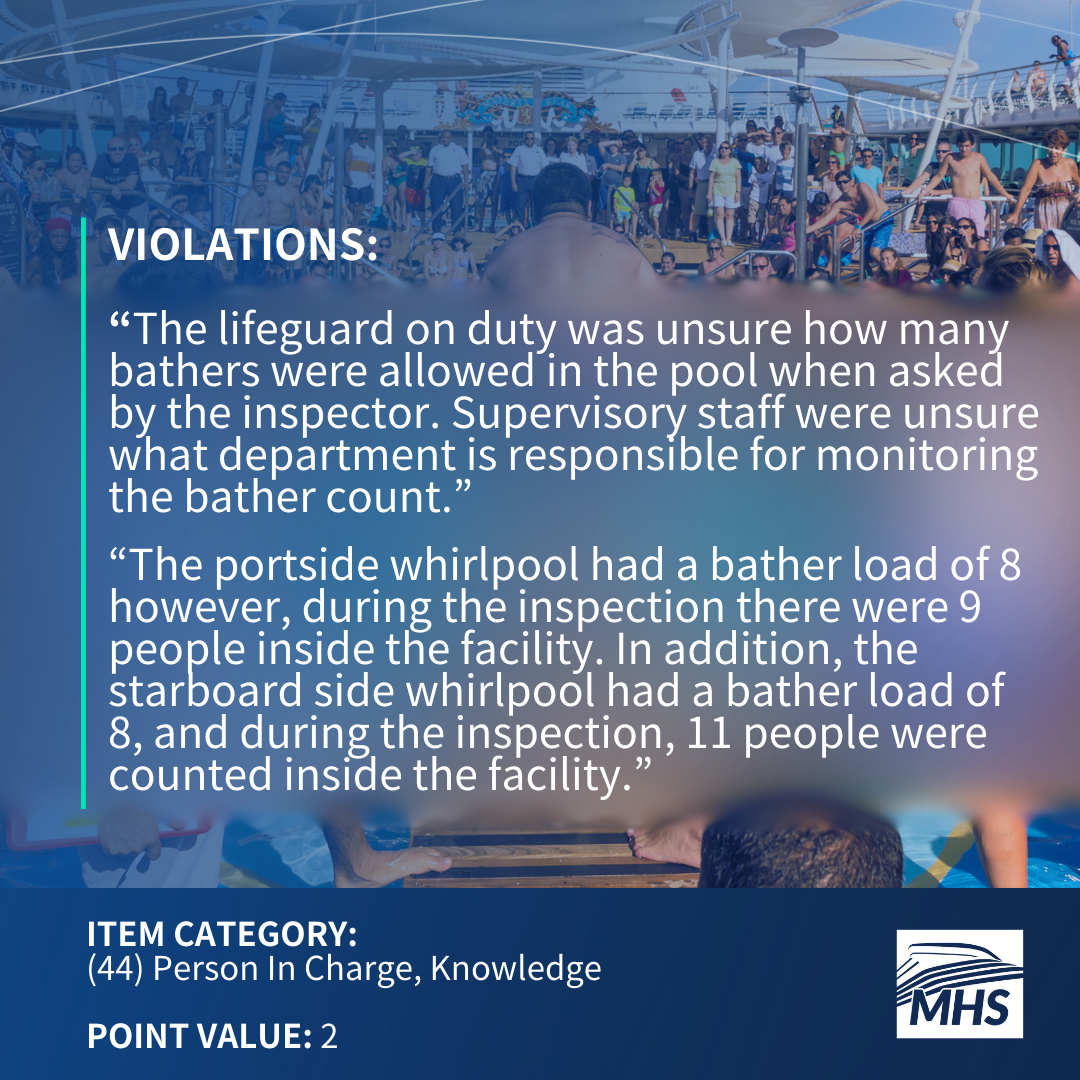
These violations highlight the importance of adhering to VSP requirements for the maximum number of bathers permitted in a Recreational Water Facility (RWF) at any given time. Determining the appropriate bather load for aquatic venues is crucial for maintaining optimal water quality and ensuring user safety.
Bather loads must be calculated for each recirculating RWF based on the volume of water and the recirculation flow rate applicable to the facility (Section 6.3.1.5 Bather Loads). Additionally, signs must be posted at the venues to notify passengers of the maximum occupancy limits (Section 6.8.1.1.1 General RWF Signs).
These findings are intriguing because they highlight a grey area in ensuring adherence to bather load policies. Most vessels do not have lifeguards, raising questions about how effectively other assigned staff, such as security guards or housekeeping personnel, can guarantee that bather loads are not exceeded when aquatic venues are open.
While bather load compliance might not seem like a top priority at first glance, exceeding bather load limits in RWFs can result in several health risks, including:
- Water Contamination: More bathers mean more contaminants which can overwhelm the pool’s filtration and disinfection systems.
- Chlorine Demand: High bather loads increase the demand for chlorine, which can result in insufficient disinfection if not properly managed.
- Chemical Imbalance: Overcrowding can disrupt the chemical balance of the water, making it more difficult to maintain safe pH and chlorine levels.
- Safety: Too many bathers increases the risk of accidents, which can lead to injuries.
- Air Quality: High bather loads can also affect indoor air quality in enclosed pool areas, leading to respiratory problems due to the buildup of chloramines (byproducts of chlorine reacting with organic matter).
5. Outbreak Prevention & Response Plans
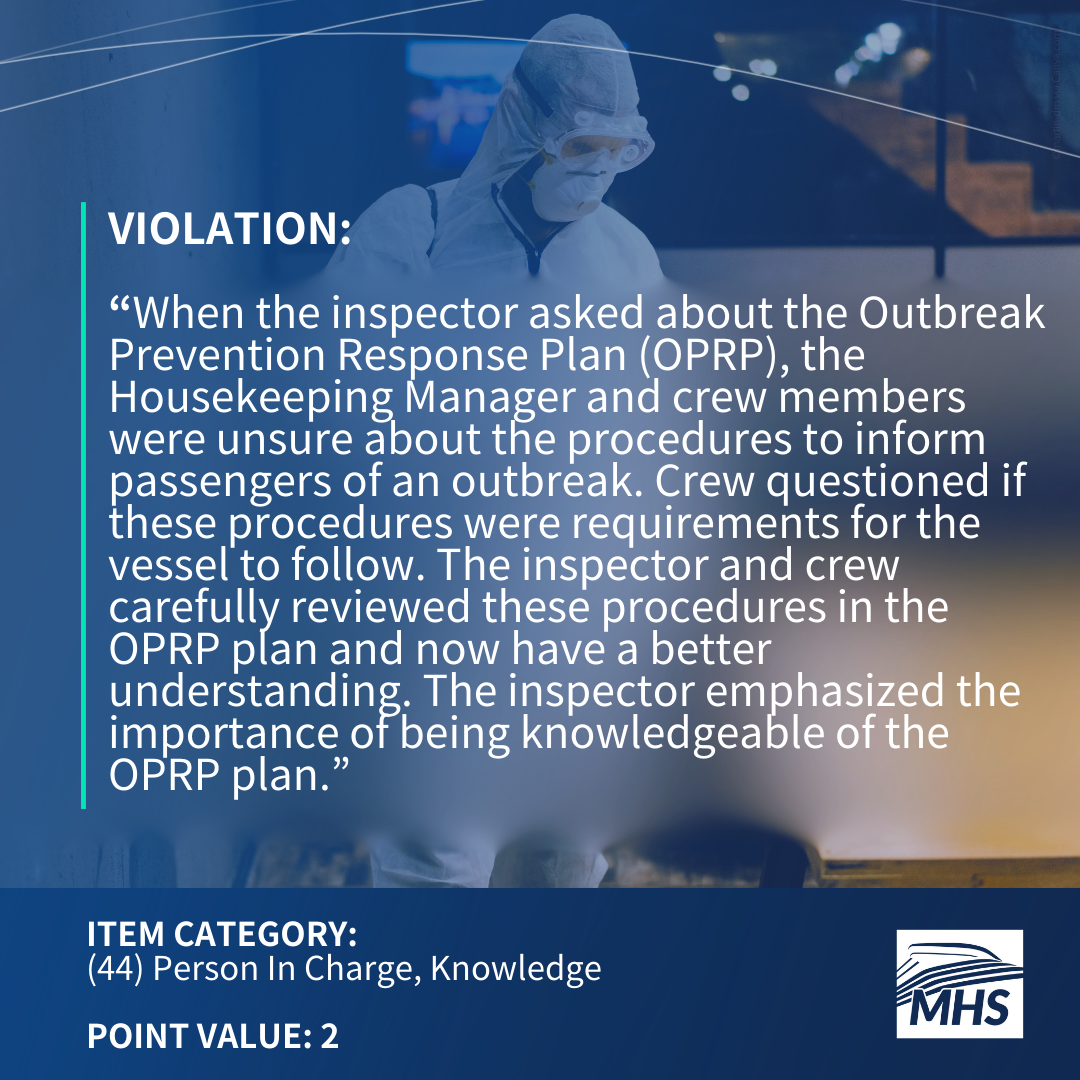
There is some sympathy for the supervisor in this situation. No cruise line today assigns the responsibility of informing passengers about an AGE outbreak to a Housekeeping Manager. Such decisions are generally made by senior executives ashore, with the wording of any announcements or written notification letters carefully reviewed by company communication and legal teams before the Captain is given the green light to notify guests about an increase in cases on board.
However, the VSP standards for outbreak management are included in the Housekeeping section of the Ops Manual. Section 9.1.1.1.5 Written OPRP outlines the components of the written OPRP each vessel must have. This includes requirements for informing passengers and crew when necessary. Furthermore, Section 9.2.1 Demonstration of Knowledge states that the person in charge of housekeeping operations on board must be able to demonstrate their knowledge about the requirements detailed in the section to inspectors when asked.
Thus, if you are a Housekeeping Manager, the best advice is to ensure you are thoroughly familiar with the vessel’s OPRP. If any of the VSP requirements are not covered in the plan, raise it with those responsible ashore.

